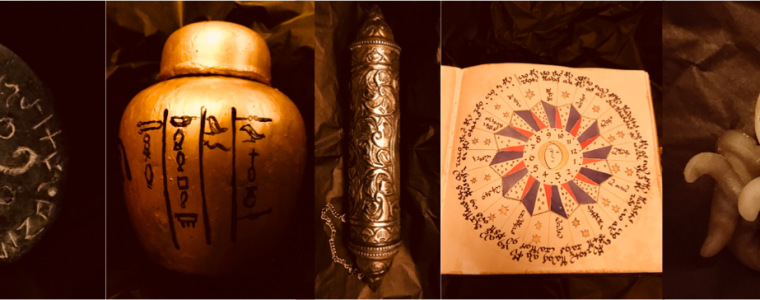It may seem strange to non-LARPers that the death of a character in a game can be extremely emotionally affecting. As an entertainment, a friend of mine once ran a one-evening horror LARP two nights in a row, one evening attended by regular LARPers, and another evening by interested work colleagues. The event was in some respects inspired by the murder mystery genre, and there came a point when the players discovered a body hidden in an attic. The LARPers responded with extreme performances of distaste and shock, while the non-LARPers made some indicative remarks over how unfortunate it was and quickly set to ghoulishly examining the body for clues. When some of their own party were in turn murdered, the distinction between the two groups’ behaviour remained evident.
In such a short timespan, it is hardly to be expected that either group would develop a genuinely strong connection to their character. Equally, the non-LARPer contingent in this case were less involved in the initial development of their character’s history and background. Furthermore, these characters were played for no more than an evening. In fantasy LARP, however, some players perform the same characters for over a decade. Even more than actors in a long running West End/ Broadway production, these performers become closely entwined with their performed alter ego. The ‘part’ is written by them, for them. They costume the character, develop their history, respond independently to life events. And if actors feel a sense of loss at the end of a long run of performances, LARPers too may have an emotional response to an end where the character can no longer be played.
There are of course in-character responses to death which are separate to the out- of-character response to the loss of a character. As I am considering character death generally I am not going to discuss the IC responses, although they are varied and interesting in their own right, particularly in the relation IC responses have to OC responses (see previous post on Immersion versus PvP). Last week I attended an academic workshop on death and loss which made me realise there might be correlations between the tangible experiences of losing a character, and how it could compare (albeit in a ‘thin’ way) to the loss of a loved one.
What comprises ‘death’ in LARP?
In the majority of different LARP systems there is an established mechanism for ‘death’. Under particular circumstances, the character enters a liminal condition which requires intervention from other players to preserve their ‘life’. The character may have limited or no participation in this process (for example, they may be ‘unconscious’ or they may be able to demand help). Without this intervention, the character will ‘die’ and the player loses all claim or control of that narrative and performance (there are some few exceptions, as when the organisers might find it useful to transform the ‘dead’ character into a threatening zombie or guardian spirit, but the discretion lies with the organisers and no longer wholly with the player).
Fear of death
While characters may have a particular attitude to death appropriate to the culture and setting of the game, players are likely to have a healthy reserve about the death of their character from the offset. On a basic level, to die is for the game to end, to ‘lose’ in some form. If the player is competing on systemic advancement of the character with other players, death eliminates all acquired advantages. If the player’s intent is to engage in the game on a narrative basis, then the narrative is completed or cut short dependant upon the circumstances of the death. All developed ties to other characters cannot continue with the player in a new identity, even if they re-enter the same game, therefore there is something of a ‘social death’ experience. Finally, costume and props which may represent significant investment of time and money can also become unusable or have limited applicability in the next role.
Each of these aspects is something that a player may justifiably ‘fear’; yet does this constitute a fear of ‘death’ or is that instead a matter of a transfer of emotion from performed to embodied self? This touches upon a difficult area. While the Scandinavian model of LARP may encourage the pursuit of ‘bleed’ and emotional transfer between player and character, this is not widely held to be the case in Britain. Instead, the performance of emotion is applauded, but any inability to maintain the distinction between self and character is an infringement of a fundamentally cherished principle of the game.
Recalling several near-death and death experiences of my own in LARP, one aspect which does seem to strike home is the narrative aspect regarding being ‘ready’ for death. I have experienced some deaths which I felt were ‘good’ in that they fit with the narrative I was attempting to portray, and others which were troubling in the sense that they were unexpected, or followed periods of uncertainty. In every case I have felt a little upset, often proportional to the length of time I invested in the character; however I do not expect that my experiences reflect those of everyone. I may discuss these instances further in relation to social connections and the role of momentos in a later post.
Ignorant of the rules – avoiding death
One of the most controversial issues in LARP surrounds the administrative process of death and its associated loopholes. In one large well known LARP system, characters are marked as dead by cutting the player’s laminated card in half with scissors. This can only be done by a referee. In other systems players must self-declare as dead, a type of altruistic suicide which preserves the integrity of the rules system. In the minority of games I have experienced, the referees or game organisers take whole responsibility for the character’s lifespan, and will inform the player of their status accordingly. Each and every system of this type works on a basic set of principles (the rules system), and upon trust among the players and the organisers. However, there are instances where that trust is infringed or broken, through ignorance or arrogance. I confess to making mistakes of ignorance myself, although I was lucky enough to have a referee on hand at the time to correct me. My short term memory is particularly poor and I have a tendency to miss things in the heat of the moment. However, when players specifically set out to ‘cheat’ death, this suggests that it is indeed something to fear. That such circumstances do exist lends some support to the idea that perhaps death in LARP does have some significance for players that is more than the sum of its inconveniences listed above.
Finally, the distinctive scenario of a game populated by LARPers and one populated by non-LARPers demonstrated one distinctive difference. Those who were not used to playing this sort of game, in concentrating on the puzzle solving element, were inclined to ‘forget’ their responses to wounds and the death of other characters after a few moments. They focussed on ensuring the solution was found to the outlandish scenario they found themselves in. The LARPers familiar with the format instead seemed to revel in the emotive responses which frustrated their overall aims, struggling on despite their ‘psychological’ and ‘physical’ limitations. I do not know which group had more fun.
Comments welcome as always.

